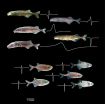(Press-News.org) WASHINGTON -- Chronic marijuana use by teenage boys does not appear to be linked to later physical or mental health issues such as depression, psychotic symptoms or asthma, according to a study published by the American Psychological Association.
Researchers from the University of Pittsburgh Medical Center and Rutgers University tracked 408 males from adolescence into their mid-30s for the study, which was published in Psychology of Addictive Behaviors.
"What we found was a little surprising," said lead researcher Jordan Bechtold, PhD, a psychology research fellow at the University of Pittsburgh Medical Center. "There were no differences in any of the mental or physical health outcomes that we measured regardless of the amount or frequency of marijuana used during adolescence."
Marijuana use has undergone intense scrutiny as several states and the District of Columbia have legalized the drug, prompting the researchers to examine whether teen marijuana use has long-term health consequences. Based on some prior studies, they expected to find a link between teen marijuana use and the later development of psychotic symptoms (delusions, hallucinations, etc.), cancer, asthma or respiratory problems, but they found none. The study also found no link between teen marijuana use and lifetime depression, anxiety, allergies, headaches or high blood pressure. This study is one of just a few studies on the long-term health effects of teen marijuana use that have tracked hundreds of participants for more than two decades of their lives, Bechtold said.
The research was an offshoot of the Pittsburgh Youth Study, which began tracking 14-year-old male Pittsburgh public school students in the late 1980s to analyze various health and social issues. For 12 years, participants were surveyed annually or semiannually, and a follow-up survey was conducted with 408 participants in 2009-10 when they were 36 years old. The study sample was 54 percent black, 42 percent white and 4 percent other races or ethnicities. There were no differences in the findings based on race or ethnicity.
Participants were divided into four groups based on their reported marijuana use: low or non-users (46 percent); early chronic users (22 percent); participants who only smoked marijuana during adolescence (11 percent); and those who began using marijuana later in their teen years and continued using the drug (21 percent). Early chronic users reported much higher marijuana use, which rapidly increased during their teens to a peak of more than 200 days per year on average when they were 22 years old. Their marijuana use then declined somewhat as they got older.
The researchers controlled for other factors that could have influenced the findings, including cigarette smoking, other illicit drug use, and participants' access to health insurance. Since the study included only males, there were no findings or conclusions about women. Relatively few participants had psychotic symptoms, according to the study.
"We wanted to help inform the debate about legalization of marijuana, but it's a very complicated issue and one study should not be taken in isolation," Bechtold said.
INFORMATION:
Article: "Chronic Adolescent Marijuana Use as a Risk Factor for Physical and Mental Health Problems in Young Adult Men;" Jordan Bechtold, PhD, and Dustin Pardini, PhD University of Pittsburgh Medical Center; Theresa Simpson, MA, and Helene R. White, PhD; Rutgers University; Psychology of Addictive Behaviors; published online Aug. 3, 2015.
Full text of the article is available from the APA Public Affairs Office and at
http://www.apa.org/pubs/journals/releases/adb-adb0000103.pdf.
Contact: Jordan Bechtold at beardsleejb@upmc.edu or (949) 291-7520.
The American Psychological Association, in Washington, D.C., is the largest scientific and professional organization representing psychology in the United States. APA's membership includes more than 122,500 researchers, educators, clinicians, consultants and students. Through its divisions in 54 subfields of psychology and affiliations with 60 state, territorial and Canadian provincial associations, APA works to advance the creation, communication and application of psychological knowledge to benefit society and improve people's lives.
http://www.apa.org
If you do not want to receive APA news releases, please let us know at public.affairs@apa.org or 202-336-5700.
HIV can continue to grow in patients who are thought to be responding well to treatment, according to research by the University of Liverpool.
During treatment for HIV the virus hides in blood cells that are responsible for the patient's immune response. The virus does this by inserting its own genetic information into the DNA of the blood cells, called CD4 Tlymphocytes.
The study by the University's Institute of Infection and Global Health measured the levels of integrated HIV in the CD4 cells of patients undergoing uninterrupted treatment for up to 14 years, and ...
A super-dense star formed in the aftermath of a supernova explosion is shooting out powerful jets of material into space, research suggests.
In a study published today, a team of scientists in the Australia and the Netherlands has discovered powerful jets blasting out of a double star system known as PSR J1023+0038.
It was previously thought that the only objects in the Universe capable of forming such powerful jets were black holes.
PSR J1023+0038 contains an extremely dense type of star astronomers call a neutron star, in a close orbit with another, more normal ...
Flight simulators for the training of air pilots are well known. But what about riding simulators? Although the first horse simulator was used at the French National Equestrian School in Saumur already in the 1980s, riding simulators for dressage, show jumping, polo or racing, have become available only recently. They look like horses and respond to the aids of the rider via sensors which measure the force exerted by the reins and the rider's legs. Via a screen in front of the simulator, the rider immerses himself into a virtual equestrian world.
Simulators are aimed ...
Scientists first had to re-think death before they could develop a way of testing the potential harm to the environment caused by thousands of chemicals humankind uses each day.
Researchers led by Dr Roman Ashauer, of the Environment Department at the University of York, refined the technique of survival analysis used routinely by toxicologists, biologists, medical researchers and engineers. The research could pave the way for testing the estimated 15,000 substances discovered daily.
Survival analysis which helps to predict a huge range of functions such as the survival ...
New research by scientists at New Zealand's University of Otago and GNS Science is helping to solve the puzzle of how bacteria are able to live in nutrient-starved environments. It is well-established that the majority of bacteria in soil ecosystems live in dormant states due to nutrient deprivation, but the metabolic strategies that enable their survival have not yet been shown.
The researchers took an extreme approach to resolving this enigma.
They studied a strain of acidobacteria named Pyrinomonas methylaliphatogenes that was cultivated from heated and acidic geothermal ...
A study including researchers from the U.S. Department of Energy's Argonne National Laboratory and the University of Chicago found evidence that gut microbes affect circadian rhythms and metabolism in mice.
We know from studies on jet lag and night shifts that metabolism--how bodies use energy from food--is linked to the body's circadian rhythms. These rhythms, regular daily fluctuations in mental and bodily functions, are communicated and carried out via signals sent from the brain and liver. Light and dark signals guide circadian rhythms, but it appears that microbes ...
The more than 200 species in the family Mormyridae communicate with one another in a way completely alien to our species: by means of electric discharges generated by an organ in their tails.
In a 2011 article in Science that described a group of mormyrids able to perceive subtle variations in the waveform of electric signals, Washington University in St. Louis biologist Bruce Carlson, PhD, noted that another group of mormyrids are much less discriminating (see illustration).
The fish with nuanced signal discrimination can glean a stunning amount of information from ...
Cleaning up municipal and industrial wastewater can be dirty business, but engineers at the University of Colorado Boulder have developed an innovative wastewater treatment process that not only mitigates carbon dioxide (CO2) emissions, but actively captures greenhouse gases as well.
The treatment method, known as Microbial Electrolytic Carbon Capture (MECC), purifies wastewater in an environmentally-friendly fashion by using an electrochemical reaction that absorbs more CO2 than it releases while creating renewable energy in the process.
"This energy-positive, carbon-negative ...
(BOSTON) - Super productive factories of the future could employ fleets of genetically engineered bacterial cells, such as common E. coli, to produce valuable chemical commodities in an environmentally friendly way. By leveraging their natural metabolic processes, bacteria could be re-programmed to convert readily available sources of natural energy into pharmaceuticals, plastics and fuel products.
"The basic idea is that we want to accelerate evolution to make awesome amounts of valuable chemicals," said Wyss Core Faculty member George Church, Ph.D., who is a pioneer ...
Some neutron stars may rival black holes in their ability to accelerate powerful jets of material to nearly the speed of light, astronomers using the Karl G. Jansky Very Large Array (VLA) have discovered.
"It's surprising, and it tells us that something we hadn't previously suspected must be going on in some systems that include a neutron star and a more-normal companion star," said Adam Deller, of ASTRON, the Netherlands Institute for Radio Astronomy.
Black holes and neutron stars are respectively the densest and second most dense forms of matter known in the Universe. ...


